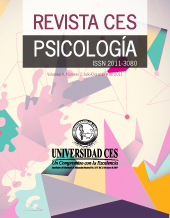Adaptation and evaluation of the psychometric properties of brief-p in colombian preschoolers
DOI:
https://doi.org/10.21615/cesp.10.1.4Keywords:
Executive Functions, Evaluation, Preschool, BRIEF-P, Test Validity, Test ReliabilityAbstract
Executive functions are a series of processes that coordinate other cognitive functions, emotional and behavioral responses, especially to novel problems. Its evaluation is important in the preschool years in order to prevent learning and behavior problems. In this study, we adapted the Behavior Rating Inventory of Executive Function - Preschool Version (BRIEF-P), and we evaluated its psychometric properties with a sample of 125 Colombian children between 2 and 4 years eleven months old, implementing several tests of reliability and validity. We found high rates of test-retest reliability and internal consistency in the overall composite score, the three indices and the five scales of the instrument, and a structure of correlations between the scales above .50. Five factors accounted for 100% of the variance and the BRIEF-P scales correlated significantly with the score obtained in performance tests designed for evaluate executive functions in preschoolers. These data indicate that the instrument has adequate psychometric properties, although a study of normalization it is recommended.
Downloads
References
Achenbach, T. M., & Rescorla, L. A. (2000). Manual for the ASEBA Preschool Forms & Profiles. Burlington, VT: University of Vermont, Research Center for Children, Youth, & Families.
Azcoaga, J. (2008). Estado de la neuropsicología infantil. Acta Neurológica Colombiana, 24 (2, Supl.), S5-S16.
Banco Mundial (2011). Aprendizaje para todos: Invertir en los conocimientos y las capacidades de las personas para fomentar el desarrollo. Washington D.C.: Autor.
Bauselas, E. (2010). Función ejecutiva y desarrollo en la etapa preescolar. Boletín de Pediatría, 50 (214), 272 – 276.
Carlson, S. (2005). Developmentally sensitive measures of executive function in preschool children. Developmental Neuropsychology, 28 (2), 595-616.
Clark, C., Pritchard, V., & Woodward, L., (2010). Preschool executive functioning abilities predict early mathematics achievement. Developmental Psychology, 46 (5), 1176-1191.
Espy, K., Kaufmann, P., Glisky, M., & McDiarmid, M. (2001). New procedures to assess executive functions in preschool children. The Clinical Neurospsychologist, 15 (1), 46-58.
Fletcher, J. (1996). Executive functions in children: Introduction to the special series. Developmental Neuropsychology, 12 (1), 1-4.
Flores, J., Ostrosky-Solís, F., y Lozano, A. (2008). Batería de Funciones Frontales y Ejecutivas: Presentación. Revista Neuropsicología, Neuropsiquiatría y Neurociencias, 8 (1), 141-158.
Gioia, G., Espy, K., & Isquit, P. (2003). BRIEF-P: Behavior Rating Inventory of Executive Function Preschool Version. Professional Manual. Florida: PAR.
González, M., y Ostrosky, F. (2012). Estructura de las funciones ejecutivas en la edad preescolar. Acta de Investigación Psicológica, 2 (1), 509-520.
Gregory, R. (2012). Pruebas Psicológicas: Historia, principios y aplicaciones (6ª Ed.) México: Pearson.
Hernández, R., Fernández, C., y Baptista, P. (2006). Metodología de la Investigación (4ª Ed.) México: Mc. Graw Hill.
Isquith, P., Crawford, J., Espy, K., Gioia, G. (2005) Assessment of executive function in preschool-aged children. Mental Retardation & Developmental Disabilities Research Reviews,11(3), 209–215.
Kerlinger, F., y Lee H. (2002). Investigación del comportamiento (4ª Ed.) México: McGraw Hill.
Kline, R. B. (2005). Principles and practice of structural equation modeling (2a Ed.). New York, NY: Guilford Press.
McGoey, K.E., Bradley,-Klug, K., Crone, D., Shelton, T.L., & Radcliffe, J. (2000, Abril). Normative data of the ADHD-Rating Scale-IV-Preschool version. Trabajo presentado en la convencion annual de la National Association of School Psychologists, New Orleans, Louisiana.
Mahone, E., & Hoffman, J. (2007). Behavior ratings of executive function among preschoolers with ADHD. Clinical Neuropsychologist, 21 (4), 569-586.
Méndez, I., y Nahimira G. D. (2000). El protocolo de investigación: Lineamientos para su elaboración y análisis. México: Trillas.
Ministerio de Salud y Colciencias (2015). Encuesta Nacional de Salud Mental 2015 (Tomo 1). Bogotá: Autores.
Muñiz, J., Elosua, P., y Hamblenton, R. (2013). Directrices para la traducción y adaptación de los tests: segunda edición. Psicothema, 25 (2), 151-157.
National Scientific Council on the Developing Child (2007). The timing and quality of early experiences combine to shape brain architecture [documento de trabajo cinco]. Disponible en: http://www.developingchild.net
Oates, J., Karmiloff-Smith, A., y Johnson, M. (2012). El cerebro en desarrollo. Aberystwyth: Cambrian Printers.
Palacios, J. E, e Hidalgo, V. (1999). Desarrollo de la personalidad desde los 6 años hasta la adolescencia. En J. E. Palacios, A. Marchesi, A. y C. Coll (Eds), Desarrollo psicológico y educación. Vol. 1: Psicología evolutiva (pp. 355-376). Alianza: Madrid.
Pérez, E., y Capilla, A. (2008). Neuropsicología infantil. En J. Tirapu, M. Rios y F. Maestrú (Eds.), Manual de Neuropsicología (pp. 441-469). Barcelona: Viguera.
Preston, S., & Waal, F. (2002). Empathy: Its ultimate and proximates bases. Behavioral and Brain Sciences, 25 (1), 1- 71.
Programa de las Naciones Unidas para el Desarrollo y Alcaldía Mayor de Tunja (2012). Política pública de primera infancia del Municipio de Tunja: Políticas Públicas para el logro de los ODM. Tunja: Linca Publicidad.
Reynolds, C. R., & Kamphaus, R. W. (1992). Behavior assessment system for children. Circle Pines, Minnesota: American Guidance Service.
Roselli, M., Jurado, M., y Matute, E., (2008). Las funciones ejecutivas a través de la vida. Revista Neuropsicología, Neuropsiquiatría y Neurociencias, 8 (1), 23-46.
Samango-Sprouse, C. (2007). Frontal lobe development in childhood. En B. Miller y J. Cummings (Eds,.), The human frontal lobes, functions and disorders (2a Ed., pp.576-596) New York: The Guilford Press.
Sánchez-Carpintero, R., y Narbona, J. (2004). El sistema ejecutivo y las lesiones frontales en el niño. Revista de Neurología, 39 (2), 188-191.
Stelzer, F., Cervigni, M., y Martino, P. (2011). Desarrollo de las funciones ejecutivas en niños preescolares: una revisión de algunos de sus factores moduladores. Liberabit, 17 (1), 93-100.
Tirapu, U., y Luna-Lario, P. (2008). Neuropsicología de las funciones ejecutivas. En J. Tirapu, M. Rios y F. Maestrú (Eds.), Manual de neuropsicología (p. 221 - 256). Barcelona: Viguera.
Thorella, L., & Wåhlstedt, C., (2006). Executive functioning deficits in relation to symptoms of ADHD and/or ODD in preschool children. Infant and Child Development, 15, 503–518.
Trujillo, N., y Pineda, D. (2008). Función ejecutiva en la investigación de los trastornos del comportamiento del niño y del adolescente. Revista Neuropsicología, Neuropsiquiatría y Neurociencias, 8 (1), 77-94.
Walker, S., Wachs, T., Grantham-McGregor, S., Black, M., Nelson, C., Huffman, S., et al. (2011). Inequality in early childhood: risk and protective factors for early child development. The Lancet, 378, 1325–1338.
Zelazo, P. (2003). The development of executive function. Monographs of the Society for Research in Child Development, 68 (3), 1-27.
Downloads
Published
How to Cite
Issue
Section
License
Copyright (c) 2016 Maritza Alexandra Rincón Díaz, César Armando Rey Anacona

This work is licensed under a Creative Commons Attribution-NonCommercial-ShareAlike 4.0 International License.
Each manuscript is accompanied by a statement specifyingThat the materials are unpublished, that have not been previously published in printed formatElectronic and that they will not be presented to any other means before knowing the decision of the magazine. ThroughoutIn case, any previous publication, sea in printed or electronic form, must be made known to the editorial staffWriting The authors attach a signed statement stating that, and the manuscript is acceptedFor publication, the rights of reproduction are the exclusive property of the Journal CES Psychology.| Article metrics | |
|---|---|
| Abstract views | |
| Galley vies | |
| PDF Views | |
| HTML views | |
| Other views | |




